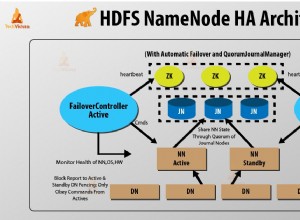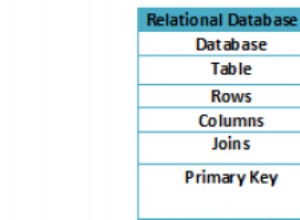In MongoDB, il $not l'operatore della pipeline di aggregazione valuta un valore booleano e restituisce il valore booleano opposto.
In altre parole, quando il booleano restituisce true , il $not l'operatore restituisce false . E quando il booleano restituisce false , il $not l'operatore restituisce true .
Esempio
Supponiamo di avere una raccolta chiamata tests con i seguenti documenti:
{ "_id" : 1, "data" : true }
{ "_id" : 2, "data" : false }
Ecco cosa succede quando applichiamo $not ai data campo di ogni documento:
db.test.aggregate(
[
{ $match: { _id: { $in: [ 1, 2 ] } } },
{ $project: {
_id: 0,
data: 1,
result: { $not: [ "$data" ] } }
}
]
)Risultato:
{ "data" : true, "result" : false }
{ "data" : false, "result" : true }
Possiamo vedere che $not restituito l'opposto di ogni booleano.
Valori zero, nulli e non definiti
Il $not l'operatore valuta 0 , null e undefined come false – il che significa che restituisce true .
Supponiamo di avere i seguenti documenti:
{ "_id" : 3, "data" : 0 }
{ "_id" : 4, "data" : null }
{ "_id" : 5, "data" : undefined }
Ecco cosa succede quando applichiamo $not :
db.test.aggregate(
[
{ $match: { _id: { $in: [ 3, 4, 5 ] } } },
{ $project: {
_id: 0,
data: 1,
result: { $not: [ "$data" ] } }
}
]
)Risultato:
{ "data" : 0, "result" : true }
{ "data" : null, "result" : true }
{ "data" : undefined, "result" : true }
Come previsto, hanno tutti restituito true (il che significa che sono stati valutati come false .
Tutti gli altri valori
Il $not operatore tutti gli altri valori come true – il che significa che restituisce false .
Supponiamo di avere i seguenti documenti:
{ "_id" : 6, "data" : [ true ] }
{ "_id" : 7, "data" : [ false ] }
{ "_id" : 8, "data" : 5 }
{ "_id" : 9, "data" : "Bat" }
{ "_id" : 10, "data" : ISODate("2021-01-03T23:30:15.100Z") }
Ecco cosa succede quando applichiamo $not :
db.test.aggregate(
[
{ $match: { _id: { $in: [ 6, 7, 8, 9, 10 ] } } },
{ $project: {
_id: 0,
data: 1,
result: { $not: [ "$data" ] } }
}
]
)Risultato:
{ "data" : [ true ], "result" : false }
{ "data" : [ false ], "result" : false }
{ "data" : 5, "result" : false }
{ "data" : "Bat", "result" : false }
{ "data" : ISODate("2021-01-03T23:30:15.100Z"), "result" : false }
Tutti restituiscono false (il che significa che restituiscono true ).
Campi mancanti
Applicazione di $not in un campo che non esiste restituisce false (il che significa che restituisce true ).
Supponiamo di avere il seguente documento:
{ "_id" : 11 }
E applichiamo $not a quello:
db.test.aggregate(
[
{ $match: { _id: { $in: [ 11 ] } } },
{ $project: {
_id: 0,
data: 1,
result: { $not: [ "$data" ] } }
}
]
)Risultato:
{ "result" : true } Nega un altro operatore
Il $not operatore può essere utilizzato per negare l'output booleano di un altro operatore.
Supponiamo di avere una collezione chiamata pets con i seguenti documenti:
{ "_id" : 1, "name" : "Wag", "type" : "Dog", "weight" : 20 }
{ "_id" : 2, "name" : "Bark", "type" : "Dog", "weight" : 10 }
{ "_id" : 3, "name" : "Meow", "type" : "Cat", "weight" : 7 }
{ "_id" : 4, "name" : "Scratch", "type" : "Cat", "weight" : 8 }
{ "_id" : 5, "name" : "Bruce", "type" : "Kangaroo", "weight" : 100 }
{ "_id" : 6, "name" : "Hop", "type" : "Kangaroo", "weight" : 130 }
{ "_id" : 7, "name" : "Punch", "type" : "Kangaroo", "weight" : 200 }
{ "_id" : 8, "name" : "Snap", "type" : "Cat", "weight" : 12 }
{ "_id" : 9, "name" : "Ruff", "type" : "Dog", "weight" : 30 }
Possiamo usare $not insieme a dire, $gt per valutare il campo peso:
db.pets.aggregate(
[
{ $project: {
_id: 0,
name: 1,
weight: 1,
result: { $not: [ { $gt: [ "$weight", 100 ] } ] } }
}
]
)Risultato:
{ "name" : "Wag", "weight" : 20, "result" : true }
{ "name" : "Bark", "weight" : 10, "result" : true }
{ "name" : "Meow", "weight" : 7, "result" : true }
{ "name" : "Scratch", "weight" : 8, "result" : true }
{ "name" : "Bruce", "weight" : 100, "result" : true }
{ "name" : "Hop", "weight" : 130, "result" : false }
{ "name" : "Punch", "weight" : 200, "result" : false }
{ "name" : "Snap", "weight" : 12, "result" : true }
{ "name" : "Ruff", "weight" : 30, "result" : true }
Per ribadirlo, eccolo di nuovo, ma questa volta emettiamo un campo per il $gt risultati, nonché il campo per il non $gt risultati:
db.pets.aggregate(
[
{ $project: {
_id: 0,
weight: 1,
gt: { $gt: [ "$weight", 100 ] },
notGt: { $not: [ { $gt: [ "$weight", 100 ] } ] } }
}
]
)Risultato:
{ "weight" : 20, "gt" : false, "notGt" : true }
{ "weight" : 10, "gt" : false, "notGt" : true }
{ "weight" : 7, "gt" : false, "notGt" : true }
{ "weight" : 8, "gt" : false, "notGt" : true }
{ "weight" : 100, "gt" : false, "notGt" : true }
{ "weight" : 130, "gt" : true, "notGt" : false }
{ "weight" : 200, "gt" : true, "notGt" : false }
{ "weight" : 12, "gt" : false, "notGt" : true }
{ "weight" : 30, "gt" : false, "notGt" : true }
Ogni volta $gt risultava true , il $not l'operatore lo ha trasformato in false . E ogni volta $gt risultava false , $not lo ha girato su true .




